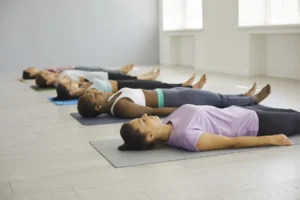Trauma can profoundly affect both emotional well-being and physical health. Many individuals struggle with chronic pain, fatigue, and other physical ailments rooted in unprocessed trauma. Integrating trauma healing exercises into fitness routines offers a holistic approach, promoting emotional recovery while enhancing physical resilience. This article explores effective practices that can bridge the gap between emotional and physical wellness, inviting a deeper understanding of how these exercises can transform lives.
Key Takeaways
- Mindfulness meditation enhances emotional resilience while improving focus and awareness during physical activities, supporting overall health goals.
- Breathwork promotes emotional release and reduces stress, which can alleviate physical tension and enhance performance during workouts.
- Gentle movements like yoga and tai chi foster physical engagement, helping to release emotions and improve flexibility and strength.
- Journaling aids in processing trauma, providing clarity that can motivate and enhance commitment to fitness routines.
- Setting realistic emotional and physical goals together fosters a sense of community and achievement, enriching the holistic wellness journey.
Understanding Trauma and Its Impact on Physical Health
Trauma, a profound psychological wound, can have far-reaching effects that extend beyond emotional distress to greatly impact physical health. Those who experience trauma may find themselves facing chronic pain, fatigue, and a weakened immune system. The body responds to trauma by releasing stress hormones, which can lead to inflammation and various physical ailments. Additionally, individuals may engage in unhealthy coping mechanisms, further exacerbating physical issues. Understanding this connection is essential for individuals seeking healing and belonging. Recognizing the interplay between mental and physical health can foster a supportive environment where individuals feel seen and understood. By acknowledging the holistic nature of trauma, one can begin to explore trauma healing exercises that promote both emotional resilience and physical well-being, creating a pathway toward recovery.
The Benefits of Integrating Trauma Healing Exercises
Integrating trauma healing exercises into a wellness routine can yield significant benefits for both mental and physical health. These exercises not only facilitate emotional release and resilience but also promote physical well-being by reducing stress and enhancing bodily awareness. The practice of trauma healing fosters a sense of community and belonging, as individuals often engage in these exercises within supportive environments. This connection nurtures shared experiences, encouraging participants to relate to one another and find solace in collective healing. In addition, exercises to help heal trauma can complement fitness goals by improving overall energy levels and body functionality. As individuals work through their trauma, they may discover newfound strength, ultimately leading to a more balanced and fulfilling life.
Effective Trauma Healing Exercises for Emotional and Physical Wellness
When individuals seek to enhance their emotional and physical wellness, effective trauma healing exercises can play a pivotal role in their journey. Practices such as mindfulness meditation help ground individuals, allowing them to reconnect with their bodies and emotions. Breathwork can also facilitate emotional release, promoting a sense of calm and clarity. Additionally, gentle movement exercises like yoga or tai chi encourage physical engagement while fostering emotional resilience. Journaling serves as a powerful tool for self-reflection, enabling individuals to process their experiences and emotions. Each of these exercises helps heal trauma, not only supports emotional healing but also contributes positively to physical health, creating a holistic approach to wellness that nurtures both body and spirit.

Creating a Balanced Routine: Combining Trauma Healing With Fitness Goals
Creating a balanced routine that harmonizes trauma healing exercises with fitness goals can greatly enhance overall well-being. Individuals seeking to integrate these practices should first identify their emotional and physical objectives. Incorporating mindfulness techniques, such as deep breathing or meditation, can help ground the individual during physical activities. Gentle movement, like yoga or walking, serves as a bridge between healing and fitness, allowing for emotional release while promoting physical health. Setting realistic goals fosters a sense of achievement, reinforcing a supportive community. Regularly reviewing progress can further motivate individuals, nurturing their journey toward holistic wellness. By blending exercises to help heal trauma with fitness aspirations, individuals cultivate resilience and connection, ultimately fostering a sense of belonging within themselves and their communities.
Real-Life Success Stories: Transformations Through Trauma Healing Exercises
Many individuals have experienced profound transformations through the practice of trauma healing exercises, showcasing the powerful connection between emotional well-being and physical health. For instance, Sarah, a former athlete, found herself struggling with anxiety after an injury. Embracing exercises to help heal trauma not only alleviated her emotional pain but also improved her physical recovery, allowing her to regain strength and confidence. Similarly, James, who faced childhood trauma, discovered that incorporating mindfulness and movement into his routine enhanced his fitness journey, ultimately leading to a healthier lifestyle. These success stories emphasize that exercises to help heal trauma can foster resilience, helping individuals reclaim their lives while simultaneously supporting their physical health goals. Such transformations highlight the importance of community and shared experiences in the healing process.
Frequently Asked Questions
Can Trauma Healing Exercises Be Done at Home?
Trauma healing exercises can indeed be performed at home, offering individuals a safe space to explore their emotions. These practices foster self-connection, promote healing, and encourage physical well-being, nurturing a sense of community and belonging.
How Long Should I Practice Trauma Healing Exercises?
The duration for practicing exercises to help heal trauma varies, but consistency is key. Individuals are encouraged to start with short sessions, gradually increasing time as comfort grows, fostering a sense of belonging and connection to their healing journey.
Are There Specific Trauma Healing Exercises for Children?
Specific exercises to help heal trauma for children often include art therapy, mindfulness activities, and play therapy. These approaches foster emotional expression and create a safe environment, helping children process their experiences while promoting resilience and connection.
Can I Combine Exercises to Help Heal Trauma With Other Therapies?
It is possible to combine exercises to help heal trauma with other therapies. Integrating approaches can enhance emotional resilience, provide extensive support, and foster a sense of belonging, ultimately promoting a holistic path toward healing and well-being.
What Should I Do if Exercises to Help Heal Trauma Trigger My Trauma?
If trauma healing exercises trigger distress, it’s crucial to pause and seek support. Consulting a therapist can provide guidance, ensuring a safe environment. Gradually re-engaging with exercises can promote healing, fostering resilience and understanding of personal limits.
Conclusion
Incorporating trauma healing exercises into one’s wellness journey offers a transformative approach that nurtures both emotional and physical health. By fostering self-awareness and resilience through practices like mindfulness, yoga, and breathwork, individuals can effectively address the intertwined nature of trauma and physical well-being. Embracing this holistic methodology not only alleviates chronic pain and fatigue but also empowers individuals to reclaim their energy, paving the way for a more balanced and fulfilling life.
You May Also Like To Read:


